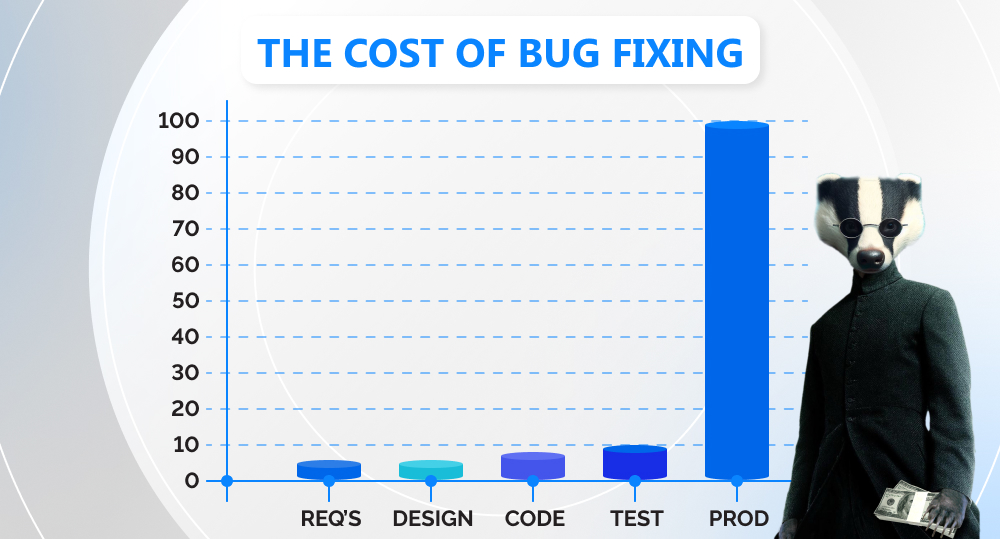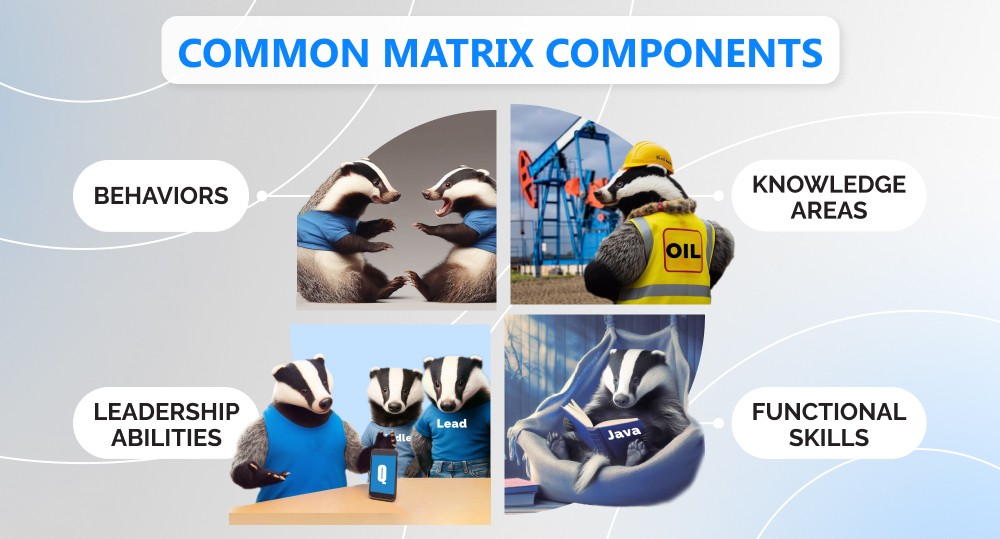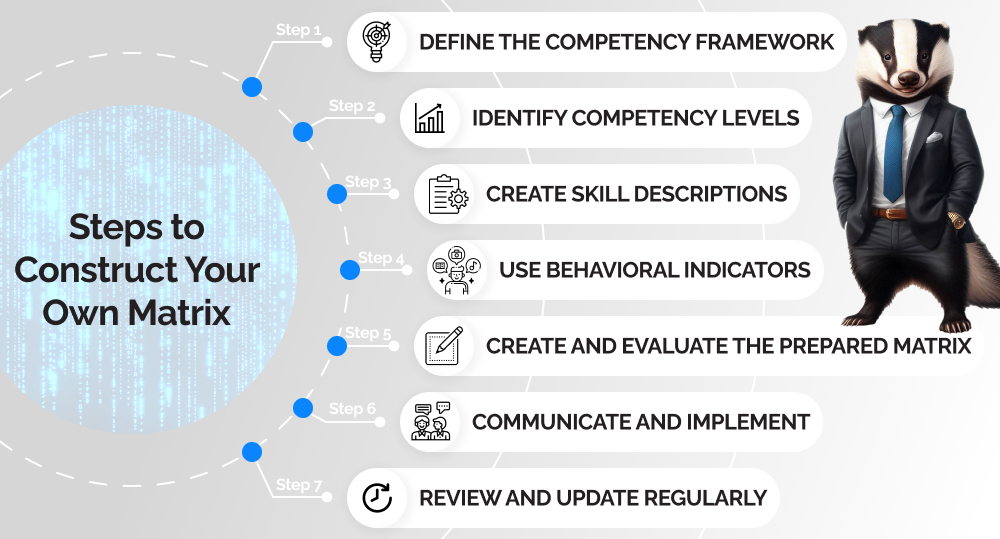Your partner said that after creating a software engineer competency matrix and evaluating their employees, they got the team the whole company always dreamt of. Can it be true?
Think back to the last time you finished a project. You just held your last client meeting, your solution seemed up and running, and the team invited you out for pizza. How did you feel at that moment? Were you completely satisfied? Or did the question “Could we have done better?” keep popping up in your mind? A competency matrix is just the thing to put your doubts to rest. Let's find out what it is and how they cook it.
written by:
Alexey Sliborsky
Solution Architect
Your partner said that after creating a software engineer competency matrix and evaluating their employees, they got the team the whole company always dreamt of. Can it be true?
Think back to the last time you finished a project. You just held your last client meeting, your solution seemed up and running, and the team invited you out for pizza. How did you feel at that moment? Were you completely satisfied? Or did the question “Could we have done better?” keep popping up in your mind? A competency matrix is just the thing to put your doubts to rest. Let's find out what it is and how they cook it.
Contents
What: Meet a Software Engineer Competency Matrix
If software development is estimated to be worth up to $500K per project, what can be the approximate cost of an engineering team's mistake? Is it half as much or more?
Errors in software engineering can cost an enterprise dearly in terms of time, resources, and credibility. Unpleasant surprises that occur in various aspects during the development process may result in missed project deadlines, financial implications, and even loss of customer trust. These consequences can have enduring effects on your company's reputation and bottom line.
To illustrate, let's examine the most sensitive point of any business — the financial aspect of a new project. As IBM has managed to calculate, the cost of software bugs grows exponentially as actual development progresses.
It's the right time to recall the common wisdom: it's better to prevent bugs than to fix them later. Guess what is the best way to implement this strategy? Right, this is to build an engineering team competency matrix, as the topic of our post suggest.
What Is It?
The engineering competency matrix is a comprehensive tool that outlines the skills and knowledge required to excel in software development. It provides a clear and structured framework for assessing the qualifications and experience of an engineering team.
The matrix is typically divided into different sectors that represent competency levels, such as junior, middle, and senior, each comprising a set of required skills that build upon the previous rank. A hierarchical structure lays out a clear career path for software engineers, serving as a roadmap for continuous professional development of both individuals and teams as a whole.
What Is in the Box?
The competency matrix covers a wide range of technical skills, including:
- Programming languages;
- Algorithms and data structures;
- Software architecture;
- Application lifecycle;
- Code refactoring techniques;
- Debugging and troubleshooting;
- Development methodologies.
It also comprises non-technical expertise, such as:
- Communication and collaboration;
- Effectiveness and delivery;
- Adaptability;
- Emotional intelligence;
- Leadership abilities;
- Strategy and innovation.
There is no general approach to selecting components for an engineering competency matrix. As with any strategic business decision, it will hinge on your key objectives. Depending on the case, it will focus on different indicators: the strengths of individual contributors, the tech skill level of the entire team, or a list of essential skills required for a newcomer.
When: Time to Craft an Engineering Competency Matrix
While competency matrices can benefit any engineering team in general, in some cases, they become particularly valuable. Here are a few scenarios when your company may need to go down this path.
Scaling and Growth
As a company expands, it gets increasingly harder to maintain consistent skill development and team cohesion. To solve this problem, an engineering competency matrix provides a standardized framework to evaluate and map the skills of existing and new employees. Plus, it can help accelerate the onboarding process.
Project Complexity
When tackling complex, large-scale projects, obtaining a complete picture of the team's abilities and expertise is vital. A competency matrix can help you identify skill gaps within the team and deliver prompt and targeted training to guarantee successful project completion.
Talent Acquisition and Retention
In a fiercely competitive job market, every software development company, regardless of its size, prioritizes the attraction and retention of exceptional engineering talent. One way to support your HR department in this effort is by providing them with an engineering competency matrix, which will clearly outline the expected skill levels for each position. Doing so will help recruiters create thorough job descriptions and establish a fair and impartial hiring process. Besides, with such matrices at hand, your employees can easily monitor the progress along their career ladder, which will surely boost their work satisfaction.
Here is how Qulix does it.
Cross-Functional Collaboration
It is common for engineering teams to collaborate closely with other departments. In such scenarios, it's crucial to have a shared understanding of employees' skills and competencies. This, again, involves the creation of an engineering competency matrix. It will build a common language for interactions between developers and copywriters, designers and QA engineers.
Performance Evaluation
Any company should develop organizational practices when engineering leaders or team leads or managers regularly review the performance of each player. The competency matrix serves precisely this purpose by providing a comprehensive and unbiased assessment of an engineer's current proficiency level. The matrix also facilitates clear communication and alignment between the employee and their team lead on expected results and career growth opportunities.
Team Training
If your organization is committed to promoting a culture of ongoing learning and improvement, a competency matrix can play a key role is building it. By regularly assessing and tracking the progress of your team members, you can offer targeted training and development opportunities to help them advance their careers. This, in turn, can boost employee satisfaction and retention.
Why: Reasons Behind Building an Engineering Competency Matrix
Subject
Reasons
Employees
- Carry out their responsibilities more effectively;
- Understand the expectations for their roles and plan their professional development accordingly;
- Recognize their strengths and weaknesses;
- Receive unbiased performance appraisal and feedback.
Team Leads
- Make more informed decisions when hiring, promoting, and training staff;
- Identify gaps in knowledge of employees and take appropriate measures to address them;
- Evaluate software engineers’ performance and provide targeted feedback for continuous improvement.
HR Departments
- Better align recruitment and hiring processes;
- Clearly define the required competencies for each level or role;
- Promote a culture of fairness and meritocracy in the team;
- Ensure engineers are in line with company objectives;
- Design targeted training programs.
Clients
- Ensure they receive services from qualified professionals;
- Use the skills matrix as a benchmarking tool when comparing different service providers;
- Assess their own requirements to match them with the skills and expertise of potential employees.
How: Steps to Construct Your Own Matrix
Enough theory, it's time to move into practice. By following these steps, you will develop an informative engineering competency matrix that will link individual skills to organizational goals and facilitate meaningful career development of software engineers.
Step #1. Define the Competency Framework
Start by identifying the core expertise areas for a role of a software developer in your organization. These competencies generally include hard skills, such as data structures, algorithms, object-oriented programming, and testing tools, along with soft skills like conflict resolution, collaboration, and leadership abilities. Ensure that the competencies you choose reflect your company's culture and values.
Step #2. Identify Competency Levels
Determine the degree of proficiency required for each of the selected competencies. You can use a numerical rating system or scale, such as entry-level, junior, middle, senior, and lead. Specify distinct benchmarks for every level to provide engineers with clear expectations and goals to strive towards.
Step #3. Create Skill Descriptions
Write detailed descriptions for each proficiency level outlining the expected knowledge and abilities. They should explain the eligibility criteria for each tier, allowing software engineers to self-assess their abilities and track the progression through the career ladder.
Step #4. Use Behavioral Indicators
To add objectivity and detail to the skill descriptions, include behavioral indicators that demonstrate the manifestation of each competency. Here's an example you can use for a Java developer: “Mentors and reviews the code of other Java developers and provides constructive feedback.” To spark more inspiration, you can also explore this example created by the US Department of the Interior.
Step #5. Create and Evaluate the Prepared Matrix
Organize the identified knowledge areas into a matrix. The result should have proficiency levels as rows and competencies as columns, or vice versa. This structure allows for a comprehensive assessment of an engineer's skills and expertise along several dimensions.
Step #6. Communicate and Implement
Once finalized, share the engineering competency matrix with your team and explain its purpose and benefits. Help engineers understand how their skills and competencies contribute to their personal development and the overall success of the organization. Foster an environment that promotes continuous learning and growth, with the matrix serving as a guide for career advancement.
Step #7. Review and Update Regularly
Conduct an ongoing evaluation and update of the competency matrix to ensure its alignment with evolving industry trends and business processes.
Bonus tip: after analyzing the data from the engineering competency matrix, try not only to give feedback to your team, but also gather employee reviews on its use. This approach fosters a trustworthy atmosphere that values your colleagues' input.
Ready-to-Use Competency Matrix Templates for Developers
Whether you’re a project manager, team lead, or HR professional, our templates can help you take the guesswork out of assessing your team’s skills. Below are fragments of the matrices that Qulix, in particular, uses in its work. Each of them is customizable and extensible, so feel free to add or remove skills, adjust proficiency levels, and include more evaluation criteria as needed.
1) Engineering Competency Matrix: Career Development Path
Junior .NET Developer*
General
.NET Core
Web
Data Storage
Soft Skills
Object-oriented programming (OOP)
- Architectural components;
- Statements, expressions, and operators;
- Interfaces;
- Arrays;
- Strings.
T-SQL:
- SIUD/CRUD;
- JOINs;
- HAVING;
- GROUP BY;
- Transactions.
Responsibility
Basic design patterns:
- Template Method;
- Abstract Factory;
- Strategy;
- Singleton;
- Repository.
Threading:
- Managed threading basics;
- Managed threading best practices.
ASP.NET MVC:
- Basic knowledge;
- App lifecycle;
- Routing;
- UI, layouts, and themes;
- Testing & debugging;
- Deployment.
RDBMS:
- Optimistic & pessimistic locks;
- Types of database relationships;
- MS SQL Server: authentication modes.
Good learning ability
Source control systems
HTTP standard:
- Protocol parameters;
- Message;
- Request;
- Response;
- Entity;
- Connections;
- Method definitions.
Solid knowledge of the software development process
Bug and issue tracking systems
- REST Services: basics;
- Web Services: basics.
- Manageabi-lity;
- Questioning skills.
*Properly compiled matrices should be divided into levels (junior, middle, senior, etc.) and areas (Java, .NET, C++, etc.). This is because the development industry now demands T-shaped specialists with knowledge in at least two areas of software engineering.
2) Engineering Competency Matrix: Compliance with Certain Level Requirements
Junior Java Developer
Category
Requirements
Compliance
Comments
Professional literature
“Java: A Beginner’s Guide” by Herbert Schildt
General
Object-oriented programming
General
Agile methodology
General
Source control systems
General
Spring Framework
General
Hibernate
Web
REST API
Data storage
SQL fundamentals
Soft skills
Responsibility
Soft skills
Attentiveness
Soft skills
Solid knowledge of the software development process
3) Engineering Competency Matrix: Overall Expertise of the Development Team
Skill
Priority
Category
James
Lily
Ian
John
Julia
Total
GPGS
2
Instruments
2
3
5
4
5
3.8
Android Studio
3
Instruments
3
3
4
4
5
3.8
Qase
2
Instruments
3
4
4
5
4
4
Performance testing
2
Professional skills
1
4
4
5
3
3.4
Network testing
3
Professional skills
3
4
5
5
4
4.2
Jira
1
Instruments
4
2
5
3
4
3.6
Document compilation
3
Professional skills
2
3
4
5
4
3.6
Employee coefficient
2.6
3.2
4.4
4.4
4.1
3.7
What’s Left? Measuring the Success!
Let's go back to the story at the beginning.
You have just finished the project, going out for pizza with your colleagues, and that pesky question pops into your head again: “Could we have done better?”
Then you remember a new file in your work folder named “Engineering competency matrix”. The one that you'll open tomorrow to finally evaluate the work of each team member. Consciously and with no bias.
The results may encourage you, but, let's be honest, you may also feel disappointed. Some employees may have just the right skill set to move from mid-level to senior positions, while others may not be experienced enough in software migration.
One thing is certain: individual proficiency does not determine team success. By analyzing each member's abilities and then assessing the big picture, you can figure out exactly what your team is missing. And then, finally, answer the question, “Could we have done better?”
If it turns out that your team lacks necessary specialists, Qulix is here to help you with outsourcing services for any of your development needs. Contact us, and we will handpick the top professionals in their fields for you.
P.S. Their competency matrices are included.
FAQ
We can categorize the competencies that a software engineer should possess into technical, leadership, and interpersonal. Our example is a general one; the competency requirements usually change from one company to another.
- Technical: programming languages, development methodologies, code readability, bug handling, API development, scripting, design, database management, quality assurance techniques, etc.
- Leadership: the ability to manage and lead a team, understand project requirements, plan and prioritize tasks, communicate effectively, etc.
- Interpersonal competencies: collaboration, inter-team communication, problem-solving, adaptability in a dynamic work environment, etc.
Here are the seven steps you can follow to create a basic engineering competency matrix:
- Identify key competencies: core skills and knowledge areas;
- Define competency levels: beginner, intermediate, and expert;
- Write skill descriptions for each level;
- Create a matrix after gathering the necessary information;
- Conduct competency assessment through tests, interviews, feedback from supervisors and peers;
- Analyze the results: identify your team's strengths and areas for improvement;
- Regularly update and refine the competency matrix to keep it accurate and relevant.
It is a set of parameters used to analyze and evaluate the skill sets of individual employees and their suitability for specific projects or roles within an organization.
It is a tool or framework used to evaluate the proficiency of software engineers in a company. The matrix visually represents the technical knowledge of each engineer, highlighting their expertise and skill gaps to be addressed. This allows software development companies to effectively manage engineering teams, assign appropriate tasks and projects, and identify areas for extra training or support.
Unlike a skill matrix, a competency matrix goes beyond technical expertise to incorporate the broader range of professional qualities necessary for effective project execution. These entail skills like problem-solving, communication, teamwork, leadership, and adaptability.
The foundation of this matrix is a technical background:
- Required professional reading;
- Programming language: Java, Python, .NET, and other;
- Database management: MongoDB, MySQL, Microsoft SQL Server, etc.;
- Object-oriented programming (OOP): architectural components, statements, expressions, operators, classes, types, etc.
- Source control systems;
- Quality assurance and testing;
- Software design patterns and architecture;
- Proficiency in industry-specific tools.
Project management skills are also frequently included, as they are crucial for supervising and coordinating complex projects.

Contacts
Feel free to get in touch with us! Use this contact form for an ASAP response.
Call us at +44 151 528 8015
E-mail us at request@qulix.com











